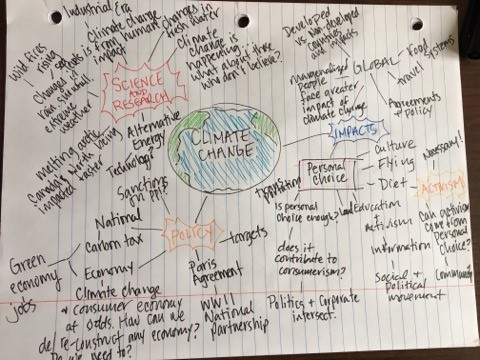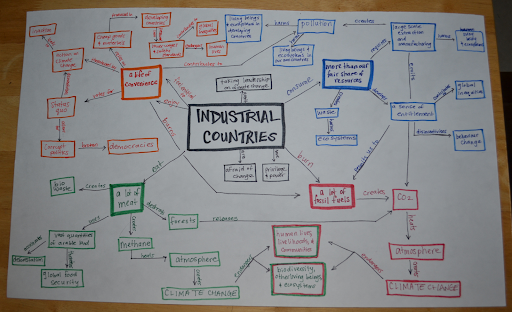Climate Change: Where are we now?
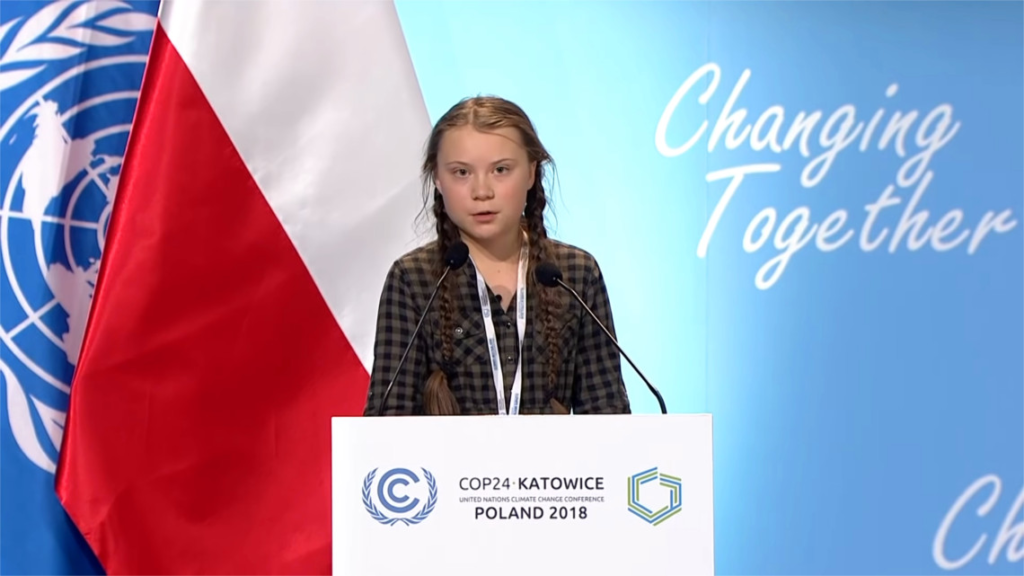
One of the many challenges of climate change is context and scale. While impacts vary from region to region, climate change is a globally shared existential threat. Over the last thirty years of climate science data and policy papers from many levels of government, it has been challenging to ascertain the impact of our collective actions, risks, and timelines. However, this has recently shifted, and more resources and tools have been developed to help individuals, communities, cities, and municipalities find answers to this question.
In this inquiry, students can explore tools and resources that help determine where we are now in terms of climate change, research big idea questions, consult with local political leaders or municipal planners, and visually map their understanding through concept mapping to explore different dimensions of climate change. They can also explore consensus on climate change, mitigation and adaptation, and policy analysis.
Jump to:
In the past 10 years, climate change has moved from a peripheral issue to one that is recognized as deserving a spot at center stage. Surveys worldwide demonstrate a general awareness and sensitivity to the issue of climate change; however, global policies do not necessarily reflect that same awareness. The actions and policies that are feasible depend in many ways on the changing attitudes of global citizens, but also on the governing bodies and their points of view.
One of the issues standing in front of major global action being taken to combat climate change, is the collective action problem. This kind of problem is defined as a situation when multiple individuals would benefit from specific actions taking place, but it is impossible for one individual to solve this problem alone. Individual countries often think of their duty to rectify the problem of climate change only in relation to their contribution to the problem, which may only be a small portion. In order to enact real change, countries and individuals need to take ownership of the problem and work together as changemakers, working to make a positive difference through cooperation and feelings of accountability. Canada is the 9th largest emitter of Greenhouse Gases, leaving worse offenders like China, the United States and Russia ahead in emissions. However per capita Canada ranks 4th on the list, and we are positioned to be more heavily impacted by the effects of global warming than many other countries, providing a very good reason to become a leader in global action.
We will now provide a brief overview of some of the key global and national policies related to climate change to date.
- Canada entered into the Kyoto Protocol in 2002 aiming to reduce GHGs by 6% between 2008 and 2012. Canada instead increased emissions by 30% and withdrew in 2011—a controversial decision for many. Reasoning was in part attributed to the lack of involvement from large contributors, China and the United States (Canadian Geographic, 2016)
- The Copenhagen Accord was signed at the UN Climate Change Conference in 2009 (aiming to reduce GHGs by 17% below 2005 levels by 2020). Canada announced in 2014 we would not meet the target.
- The Paris Agreement was signed by the Federal government in 2015, committing to spending $2.65 billion between 2015 and 2020 to support developing countries and aiming to keep global temperature rise below 2°C
- In 2019, A Climate Summit was held to check in with countries, businesses and civil societies on their commitment to the Paris agreement, and showcase any new initiatives enacted to reach their goals. According to the Climate Action Network, Canada needs more robust action in order to reach the 2030 target of reducing GHGs 30% below 2005 levels.
- At COP25 Chile, hosted in Madrid, Canada came forward with a net-zero emission legislation to achieve by 2050, with milestones every five years to remain on track. Much of the public reception of COP25 was plagued with disappointment. Executive director of Greenpeace Jennifer Morgan, told journalists that despite the “fresh momentum” provided by the growing global climate movement, it had yet to penetrate the “halls of power.”
Around the world, global climate movements are demanding more action from policymakers. Since 2019, high school students, largely inspired by Swedish teen Greta Thurnberg have participated in global climate strikes demanding action from their governments, acknowledging the weight and danger that their generation will bear and the need for urgency to divert from the current path.
In terms of policy and action, big promises and failed outcomes have brought us to the place that we are now. This is not to say that both large-scale and individual efforts have not been made. Of course, big change takes into account many important actors. Canada enacted a federal carbon tax to help incentivize reduction in emissions by taxing products that create emissions. The theory is that people will want to avoid paying this tax and subsequently reduce emissions.
To hook student interest, choose one or more of the provocation ideas to initiate student thinking.
Idea 1) News Videos
- Greta Thunberg speech at COP 24 [Connect4Climate]: 3:24 minutes – 15 year old activist Greta Thunberg speaks truth to power at the UN COP24 climate talks
- Climate Change and a path forward for Canada [The National]: 11:04 minutes – A panel discussion with three climate experts on Canada’s path forward. Catherine Abreu, from the Climate Action Network Canada, Marc Cameron from Canadians for Clean Prosperity, and Blair Feltmate from the University of Waterloo.
Idea 2) Online Resources
- Climate Action Tracker [CAT]- Read through Canada’s “Country Summary” and the “Assessment” section of the Climate Action Tracker. The Climate Action Tracker is an independent scientific analysis that tracks government climate action and measures it against the globally agreed Paris Agreement aim of "holding warming well below 2°C, and pursuing efforts to limit warming to 1.5°C."
- Carbon budget clock [Mercator Research Institute on Global Commons and Climate Change] Scroll down to the carbon budget clock. Select 2℃ and observe the timeline on the carbon budget clock then select 1.5℃ and observe the timeline.
Ask students to write “I wonders” or questions that they have after the chosen provocation. This is an opportunity for students to review the umbrella questions that they drafted in the first Inquiry: What is Climate Change and Why Care. If students have shifted their focus, encourage them to draft new questions
Here is a list of example questions:
- Are we on track to reduce warming to 1.5 or 2 degrees?
- What role does the government have in protecting local communities from the effects of climate change?
- How can we do more at a local level to mitigate the effects of climate change?
- How do we spread awareness of strong policies or lack of policies in our local community?
- How do we ensure our local community is doing their part to meet provincial, federal and global goals?
Invite a speaker
Invite a local political leader or climate adaptation planner to the class to discuss local plans.
Places to look for a climate leader
- Municipality or city – some jurisdictions have a Climate Mitigation and Adaptation Planner and others will have an Environmental Compliance Manager
- Climate Reality Project Speakers
Concept Mapping
Concept mapping is a powerful way to assess students’ understanding of key concepts and relationships. Developing a concept map on a dimension of climate change allows for students to think about relationships between systems. It also enables them to consider dimensions of climate change holistically and visually. This process also allows the teacher to identify any misconceptions or knowledge gaps that students have. A concept map can also be iterative and students can come back to their concept maps to expand or modify them as they learn. In this particular instance, concept mapping climate change would be used as a means to determine understanding and then direct student learning.
To concept map a dimension of climate change, model how to create a concept map. A concept map is comprised of key ideas or concepts (enclosed in shapes such as circles, boxes, triangles, etc.) and then a directional arrow is drawn to denote the relationship between the ideas. Along the line of the directional arrow, a preposition statement is included that explains the relationship.
Students can work individually or in small groups (4 or 5) to show what they think are the important elements/concepts of climate change. The concept map can be made through an online platform or on a large piece of chart paper with markers.
Depending on the focus of the class, here are some options for key ideas:
- Understanding of climate science: suggested concept prompts: greenhouse gases, greenhouse effect, global heating, climate, weather
- Impacts of climate change – suggested concept prompts: forest fires, flooding, deforestation, carbon cycle, water cycle, the greenhouse effect
- How people respond to climate communication – suggested concept prompts: scientists, mainstream media, government, family, friends, neighbours, companies, non-governmental organizations
- Cultural narratives – suggested concept prompts: Indigenous perspectives, Gross Domestic Product, consumerism, dominant vs minority perspectives
- Social justice of climate change – suggested concept prompts: those most at risk (vulnerable and least able to adapt), those least at risk (less impacted and able to adapt), per capita emissions, children and youth
- Climate Actions – suggested concept prompts: refrigerant management, wind turbines (offshore), reduced food waste, plant rich diet, tropical forests, educating girls, family planning, solar farms, silvopasture, and rooftop solar. These are the top 10 solutions according to Project Drawdown, students could reference the website to research and add to their concept map.
Here are a few concept map examples:
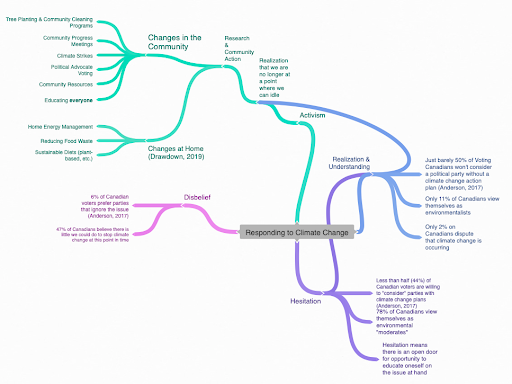
At this stage, students may begin to pursue their umbrella questions or address any gaps in their concept maps. You also may want to pause and integrate some of the following activities to ensure that students have an understanding of the current status of climate change.
The activities listed below provide activities which help scaffold key concepts of the current status of climate change and climate change policy.
- Consensus on human-caused climate change
- Mitigation & adaptation
- Policy investigation
Activity 1: Scientific Consensus on Human-caused Climate Change
Lesson from the National Center for Science Education (2018)
This lesson is designed to engage students through exploration of climate data. Students will be working in small teams to analyze samples of climate data to look for trends and consider possible “climate drivers” that they can report back to the class. Scientists make conclusions through rigorous analysis of data. In science, consensus is only reached with ample evidence and analysis of data.
Note: Climate drivers can either be anthropogenic or natural forces that result in changes to the earth’s climate. For instance, greenhouse gases are an anthropogenic climate driver, and solar activity is a natural climate driver. Any changes to these phenomena can have an impact on climate.
By interpreting real data and forming conclusions, students will only be exposed to misconceptions about climate change at the very end of the lesson, when they have already constructed their own understanding and may be able to defend this understanding in the face of misinformation. The class will explore various methods of science denial (FLICC) and examine conflicting conclusions provided by climate experts vs. a source like the ‘global petition project,’ turning misinformation into an education opportunity.
The goal of this lesson is to learn that consensus on human-caused climate change due to the burning of fossil fuels increases with expertise and to understand the strength in the 97% consensus among global climate experts.
Duration: 60 minutes
You can access the full lesson here.
Activity 2: Who’s in Control?
Resource created by Practical Action.
Students participate in a role play to explore the question of who should take responsibility for reducing the effects of climate change. Using background information provided, students represent different perspectives in a discussion/debate as to whether or not they would support a national commitment of greater emission reductions than those proposed by other countries.
The lessons conclude with students calculating their own carbon footprints and considering what practical action they are personally prepared to take to reduce greenhouse emissions.
Designed to take place over 3 class sessions, the resource provides support for students and teachers in both print and video formats.
Full resources can be accessed here.
Activity 3 (for advanced classes): Policy investigation
Using the following resources, students are invited to begin a policy investigation: The IPCC report, Canada’s commitments to the Paris Climate Agreement, Provincial Policy, and information from local government members.
The tool that students will use for this investigation is called a reverse mind map. This activity is aimed to help students examine the current status of climate change at all levels of government. Reverse Mind Mapping is a tool for navigating information overload when you have more content than you know what to do with.
This can be completed individually or in groups, with certain members splitting up to focus on one area (e.g. federal) and then sharing their findings with the rest of the group
- To complete a reverse mind map, students collect data on a specific topic (the current status of climate change in Canada), then categorize, analyze, sequence, and recognize trends surrounding the “big idea”
- Students may need to use a rough sketch and create categories and themes before creating a final product
- At the bottom of the page, students are encouraged to create a list of questions and concerns regarding how their local initiatives are meeting the federal and provincial goals set in place
Link for more information
Reverse Mind Mapping:
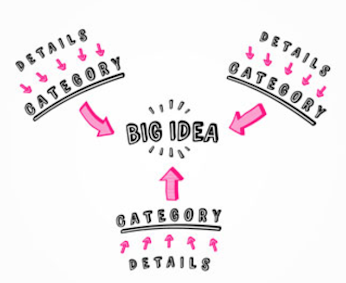
To encourage students to integrate and synthesize key ideas, configure the class into a circular seating formation and facilitate a Knowledge Building Circle.
Here are some suggested reflective questions:
- What climate impacts are we already experiencing?
- How are we personally and collectively taking action to address climate change? Where are there opportunities to direct focus and attention to taking action?
- What mitigation and adaptation efforts are we aware of?
Teachers will assess learning at different points throughout the inquiry using multiple methods. The following assessment provides an alternative evaluation method to standard quizzes and tests, that can be used after consolidation or at any point in the lesson to check for understanding.
- Thirty-Second Sound Bite Strategy: The Thirty-Second Sound Bite is an activity where, individually or in small groups, students are asked to create a 30-second sound bite that mimics what Greta did when addressing global leaders. Students will research a specific topic (of their choice) pertaining to climate change to discuss in their sound bite designed to get students’ and or listeners’ attention about an issue. For more information on this strategy look here.
Allowing time for students to take action is an essential part of the learning process on climate change, as it empowers students and eases their eco anxiety.
Ideas for Taking Action
- Invite a local political leader to the class to discuss local climate mitigation and adaptation planning and create an opportunity for student voice to reach government
- Complete a carbon footprint calculator and then develop a list of things you can personally do to mitigate carbon dioxide emissions
- Engage and partner with local community organizations that are involved in relevant projects and initiatives
Action Project Examples
- The Green Phoenix – Resurrection Catholic Secondary School – Kitchener, ON (2017)
- Students were inspired to take various actions in their community such as planting trees, advocating for better recycling programs, installing bike racks etc. But one of the major steps that these students took in their project was to educate themselves and their community. Speakers were invited for earth week to educate, inspire and help the community understand the current status about environmental issues. See their project here.
- Student Town Hall on Climate Change – Headwaters – Guelph, ON (2019)
- This student group decided to create a space for government and leaders to hear their voices to take into consideration when implementing policies and projects to ensure a more sustainable future. This took place at a youth-led town hall where any high school or elementary student could ask their Mayor, MPP and MP questions about climate change and hear open and honest answers from their government representatives. See their project here.

